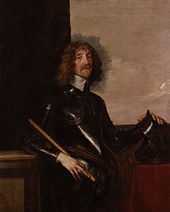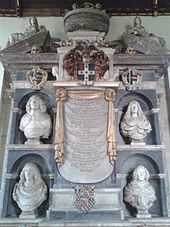Edmund Verney (Cavalier)


Sir Edmund Verney (1 January 1590[1] or 7 April 1596[2] – 23 October 1642) was an English politician, soldier and favourite of King Charles I. At the outbreak of the English Civil War he supported the Royalist cause and was killed at the Battle of Edgehill.
Life
Knighted by King James in 1611, he was sent to Madrid, and returned to join the household of Henry Frederick, Prince of Wales. Upon Henry's death in 1612, he became a gentleman of the privy chamber to Charles, Duke of York, later Charles I.[1]
His financial sense was poor, and he was severely indebted by the early 1620s. In 1623, he accompanied Charles and the Duke of Buckingham to Spain to court the Infanta Maria. While there, he protected a dying Englishman from a Catholic priest[1] by punching the priest in the face, which did not endear him to the Spaniards.
Upon his return, he was elected Member of Parliament for Buckingham in 1624, and for New Romney in 1625. After the coronation of Charles that year, he was appointed knight marshal for life, the duties of which office required him to be extensively at court. He was returned for Aylesbury in 1629. Despite his income from the knight marshalcy, several business ventures ended in failure, and his debts were largely unrelieved.[1]
With the approach of the English Civil War, he found himself in a painful conflict. While personally loyal to the King, he resisted the Laudian religious policies. Verney was returned to the Short Parliament and then the Long Parliament as member for Wycombe, and often found himself in opposition to the King.[1]
Upon the outbreak of war, Verney remained true to his master and friend, King Charles, while his eldest son Ralph joined the Parliamentary forces. Made standard-bearer of the Royal army, Verney was killed at the Battle of Edgehill. According to the tradition of his family, his body was never identified, except for his severed hand, still found grasping the banner.[1]
See also
- Claydon House, the family seat in Middle Claydon
Family
Verney was the second son of Sir Edmund Verney and Mary Blakeney. He married Margaret Denton on 14 December 1612, with whom he had ten surviving children, including:
- Sir Ralph Verney, 1st Baronet (1613–1696)
- Sir Henry Verney
- Sir Edmund Verney (1616–1649) who commanded the troops Royalist infantry in Drogheda at the Siege of Drogheda and was slain during the final assault (mentioned in Cromwell's letter to John Bradshaw, Esquire, President of the Council of State, dated 16 September 1649).[3]
- Cary Verney
References
| Wikisource has the text of the 1885–1900 Dictionary of National Biography's article about Verney, Edmund (1590-1642). |
- ↑ 1.0 1.1 1.2 1.3 1.4 1.5 Whyman, Susan E, ed. (2004). "Verney, Sir Edmund (1590–1642)". Oxford Dictionary of National Biography. Retrieved 17 September 2006.
- ↑ "Sir Edmund Verney". Retrieved 17 September 2006.
- ↑ Thomas Carlyle, Oliver Cromwell's letters and speeches: including the supplement to the first edition,, Volume 1, Harper & brothers, 1868. pp. 380,381
| Parliament of England | ||
|---|---|---|
| Preceded by Clement Coke Arthur Goodwin |
Member of Parliament for Aylesbury with Clement Coke 1628–1640 |
Succeeded by Sir John Pakington, Bt Ralph Verney |
| Preceded by Thomas Lane Sir William Borlase |
Member of Parliament for Wycombe with Thomas Lane 1640–1642 |
Succeeded by Thomas Lane Richard Browne |